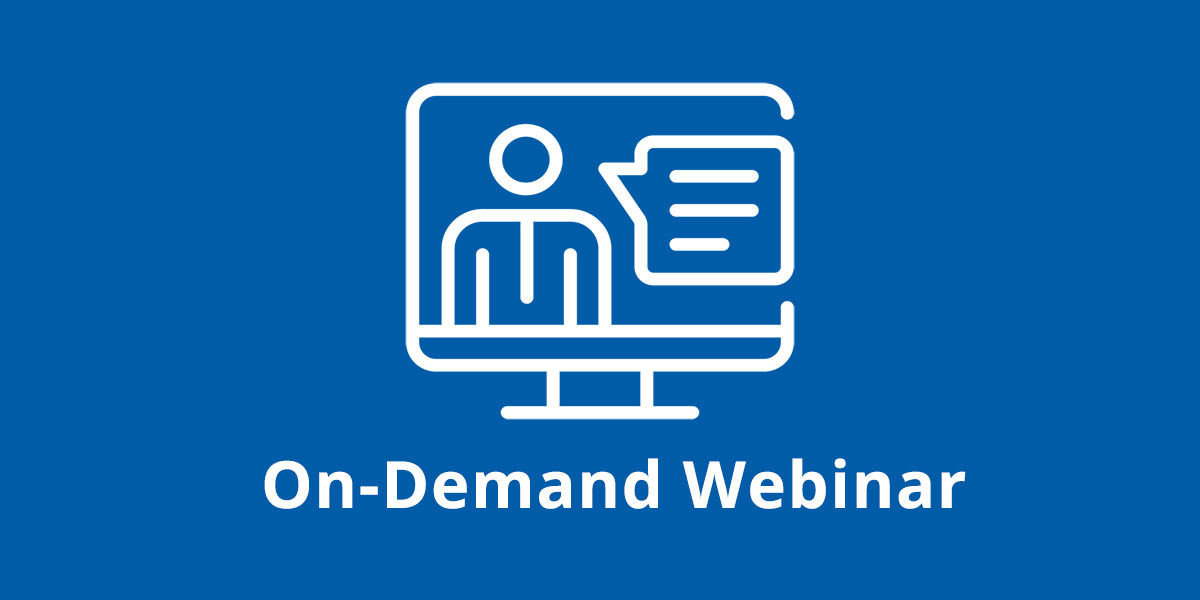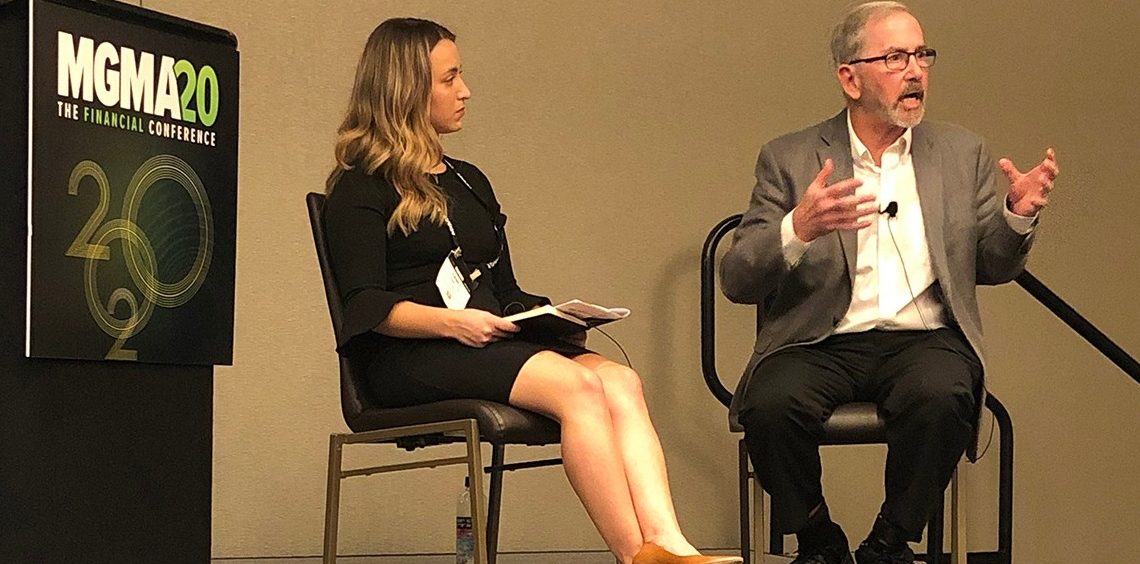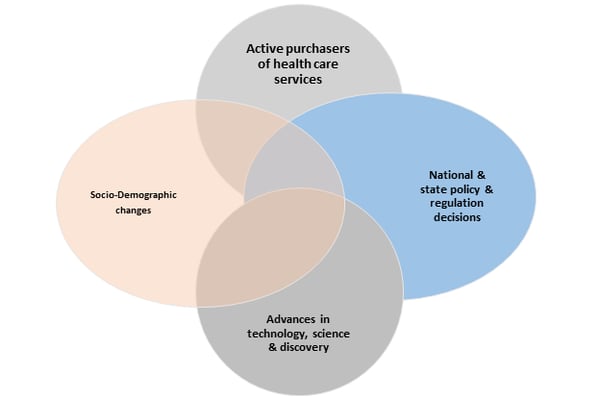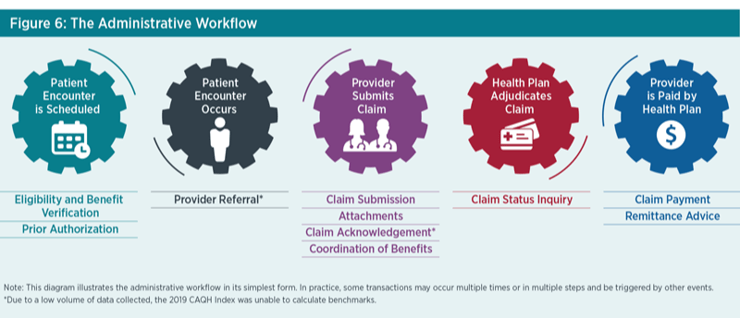We recently sat down with Professor Thomas Campanella to ask him questions about what’s next in the complex world of healthcare – after the coronavirus has subsided. We hope you find his insights valuable.
An Interview with Professor Thomas Campanella
Director of Healthcare Business Programs, Baldwin Wallace University
Question 1:
Our healthcare system in America is facing tremendous disruptions. Can you describe the impact on hospitals and health systems as a result of COVID-19?
Answer:
First of all, I would like to thank all of the healthcare workforce who have been on the front lines protecting both their patients and the community. Society owes them a debt of gratitude.
This pandemic is going to impact hospitals differently depending on their size. A large hospital system that had a reasonably good bottom line going into this is going to weather the storm much better than a system that not only has lower profit margins but also lacks financial reserves.
The financial impact could be catastrophic for some hospitals, especially smaller, rural and independent hospitals. I am especially concerned about rural hospitals, which were already facing many financial challenges. These hospitals need to receive immediate assistance from the federal government.
Question 2:
Could you identify some of the specific financial challenges hospitals are facing?
Answer:
Most hospitals just break even on much of their operations and services. Surgeries, including elective procedures, are how they generate the most revenue. The loss of that constant revenue is having a big impact on cash flow.
Many of my contacts within healthcare predict a significant amount of that volume will never be recaptured. They’re estimating that 75 percent of patients who put off elective procedures will ultimately have surgery once the pandemic passes, but 25 percent will forego surgery entirely. There could be many reasons for that. Some may be fearful of infection following the pandemic. Others may pursue less invasive therapies as an alternative to surgery.
Not only is there a reduction in revenue to contend with, there are increased expenses. The biggest concern for hospitals from a cost standpoint is labor. They’re needing to hire more staff—not just nurses, but respiratory therapists, infection control professionals and even housekeeping staff. I’m getting indications that pay could be quadrupled for these employees during this time period. They’ve had to increase compensation, almost like hazard pay. In addition, part-time nurses are becoming full-time and full-time nurses are working overtime.
Question 3:
Can you describe the impact on independent physician practices as a result of COVID-19?
Answer:
Independent physician practices are very vulnerable as a result of COVID-19, especially primary care practices which have historically low profit margins. These practices mostly rely on fee-for-service payments and many estimate they are 2-6 weeks away from running out of cash as they are already scaling back on hours and staff. To their credit, CMS has moved quickly and has shifted Medicare FFS practices to a prospective payment model.
It is now time for health insurance companies, self-insured employers (especially large employers), and local government to step up. Both health insurance companies and employers recognize the short- and long-term value of supporting a strong independent physician presence in their community. These payers need to find creative ways including immediately implementing some form of prospective payments as well as Periodic Interim Payments (PIP), to give these independent practices a cash-flow lifeline.
Question 4:
What can or should physician practices be doing to ensure they are best positioned for business when we get the all-clear from this pandemic?
Answer:
Independent physician practices need to embrace and invest in telemedicine capabilities. Physicians should not look at telemedicine as competition, but as an opportunity to provide better value to their patients and increase their geographic market. It is also a great insurance policy during times like this.
Physician practices must also look to finding ways to become more efficient as well as provide better value to their patients. This focus on efficiencies and value could result in more collaborations with third parties (telemedicine, their backroom (billing, etc.), other community providers, payers and hospitals, etc.).
Independent physician practices may also want to look to establishing collaborative relations with physician practices within their own state or the country that are in their same specialty.
Finally, there are a number of for-profit physician organizations nationally that may be open to creative ways to establish a relationship that would be beneficial to all parties.
Question 5:
What can or should hospitals, health systems be doing to ensure they are best positioned for business when we get the all-clear from this pandemic?
Answer:
Just like independent physician practices, hospitals and hospital systems need to embrace and invest in telemedicine capabilities.
Hospitals also need to aggressively focus on finding ways to increase efficiencies. Ultimately, they need to reduce costs and knock down the silos within the walls of the hospitals that have contributed to their historical operating inefficiencies.
Hospitals also need to more aggressively explore opportunities to outsource and collaborate in different ways (backroom, supply network, other providers, health insurance companies, etc.).
Question 6:
Our economy has been impacted dramatically and unemployment claims are soaring, employers are hard-hit with many possibly not able to recover, and government at all levels is experiencing unheard of financial challenges. What does all of this mean to our healthcare system?
Answer:
Our healthcare system is financed by the government (Medicare/Medicaid), employers and consumers. All of these stakeholders will be financially hurting as a result of the impact of the Coronavirus. Our federal government was already at historic highs in the national deficit. The Financial Packages that are part of the Financial Recovery effort will dramatically increase those deficits.
While hospitals will be looking for ways to enhance revenue, including financial assistance from the government, they also need to place much of their focus on reducing costs and reinventing their business model.
Hospitals will need to specifically focus on their high fixed costs which includes infrastructure, technology, and sadly, employee salaries. Hospitals will need to determine the optimal combination of infrastructure, technology, and staff to allow them to be successful in this new world of healthcare.
Inpatient admissions, long-term, will continue to decrease while the acuity level of the patient increases. Inpatient hospitals could function more like a giant ICU center.
Hospitals need to explore closing of unprofitable services and expansion of profitable services.
Hospitals will also need to find ways to be more competitive in the outpatient and home care markets. Given their financial challenges, payers (government, employers, consumers, etc.) will be demanding increased transparency (cost/quality). This will be especially difficult for hospitals and hospital systems, since their higher fixed costs will create challenges in competing against local, regional and national organizations in the fast growing outpatient and care in the home-setting arena.
As noted previously, the effective utilization of telemedicine is an example of one way a hospital could be more competitive in the outpatient and home settings. We are starting to see an acceptance of telemedicine across all generations.
Question 7:
How will these changes impact hospital employees and the local community?
Answer:
Reconfiguring the hospital inpatient setting to focus on fewer, but more higher acuity patients, will impact staffing (clinical and non-clinical), technology utilized, and less overall inpatient infrastructure.
Since there will be less focus on “routine care” in the inpatient setting, some staffing could be moved to the outpatient or home setting.
Healthcare is local, but “Life after Coronavirus” could also result in a potential reduction in clinical and non-clinical staff including, depending on their specialty, employed physicians which are part of the hospital’s fixed costs. Some of these physicians could transition to the community either with existing practices or new practices. Physicians could also establish a relationship with regional or national for-profit/non-profit organizations as well as payers (self-insured employers, commercial insurance companies, etc.).
In communities where this occurs, it would make sense for the hospitals to attempt to establish collaborative relationships with the above stakeholders.
There will also be more outsourcing and collaborations in different forms including with their supply chain which could result in clinical and non-clinical employees working for a third party that has a relationship with the hospital.
Again, depending on the hospital and the locale, hospitals/hospital systems could also leverage their investment in personnel and technology in the inpatient setting providing services to patients with higher acuity levels. There is a potential for the utilization of Centers of Excellence (COE) for certain inpatient services. The packaging of these services to regional and national self-insured employers and commercial payers could create both additional revenue for the hospital as well as employment opportunities.
In certain communities, regionally or nationally recognized hospitals already exist. “Life after Coronavirus” could result in these hospitals becoming even more focused on treating the high-risk patient both within their community, as well as regionally and nationally.
Finally, if certain hospital services are grossly unprofitable, it will also create an opportunity for hospitals in the community to collaborate together along with local governmental and non-profit entities to provide more cost-effective accessible care.
Question 8:
Wait. You are saying the hospital inpatient admissions and in-turn the hospital inpatient infrastructure will be decreasing even at a faster pace after Coronavirus? Shouldn’t it be increasing, especially, if and when something like this happens again?
Answer:
We need to compartmentalize what is occurring. We need to focus separately on the “Coronavirus time period” vs. “Life after Coronavirus.”
There are obviously immediate financial, staffing and care concerns occurring as a result of the Coronavirus, and they need to be addressed. But the hospital will also have quite a different life once we get through this pandemic.
As noted previously, there will be increased pressure from payers as well as consumers to limit utilization of services in the hospital inpatient setting (because of costs, risk of infection, etc.). Correct or not, there will be an enhanced perception that “sick people are in the hospital” and there will be increased demand for care to be provided in the outpatient and home settings.
Consequently, we also cannot afford to have hospital inpatient facilities operating with excess capacity. It would be too costly.
Question 9:
But, what if another pandemic occurs? We will be back searching for enhanced inpatient capabilities (staffing, infrastructure, supplies, etc.).
Answer:
You are correct, we have to assume that something like this pandemic will happen in the future. The question is when, not if.
We must be prepared with the ability to expand capacity, staffing, and supplies during emergency situations similar to Coronavirus. We must identify innovative approaches up-front which would allow us to adapt to such a crisis in a minimal time frame.
How? I do not have the exact answer. This is where we need to convene experts on the national, state and community level.
Ideas have already surfaced including regional publicly run hospitals that only focus on infection diseases; the conversion of Convention Centers, government buildings, etc. to hospitals; ability to adapt space in the hospital setting to accommodate crisis situations, etc. Other?
Question 10:
In general, healthcare is a very competitive industry. In the midst of the crisis, there’s a spirit of collegiality among physicians, nurses, hospitals, and health systems. Do you think competition could give way to new cooperation in healthcare? How could that benefit patients?
Answer:
There has been unprecedented collaboration and teamwork among community providers as well as with business, government, health insurance, and non-profit sectors.
This collaboration should, and needs to, continue.
We need to continue our focus on population health and addressing the social determinants of health which will require collaboration between all of the above stakeholders. Population health and addressing the social determinants of health by its very nature requires collaboration. Sadly, we have seen first-hand how the lack of sustained focus on social determinants of health has translated to an increased percentage of death as a result of COVID-19 among the less-advantaged in our communities.
Up to now, in many communities we have seen individual organizations trying to solve these big health problems in a piecemeal way. I think the collaboration we’re seeing today has shown that maybe it’s better to work together.
We cannot go back to business as usual. We still need to focus on evolving our “sick-care” system to a real “health” system.
From a revenue perspective, there can and will be more potential collaborations with the payer side (insurers, employers, etc.) such as joint ventures, revenue sharing tied to risk, etc.
Quadax 11:
Will “Life after Coronavirus” have less of a focus on risk/value-based reimbursement?
Answer:
We still need to embrace a risk/value-based payment system, which during the short-term will be challenging for health systems that utilize the “fee-for-service” (the more you do the more you make) as their lifeline.
Hospital-based Accountable Care Organizations (ACOs) need to embrace downside risk. I know that ACOs are asking for relief from downside risk, but the only way we can truly knock down the silos within and outside the walls of the hospitals is with appropriate incentives. Downside risk, while initially painful, will force efficiencies and collaborations that would not have occurred otherwise. These efficiencies and collaborations will allow both the hospital and the ACO to obtain long-term success.
All of this does not mean that in the short-run there could be somewhat of an easing on the risk-side for reimbursement arrangements. But, it needs to be just in the short-run, since it is critical that we ultimately embrace the risk/value-based approach to a better and more efficient health system.
Independent physician groups that have entered into risk arrangements with payers should specifically be looked at for potential easing or eliminating of the risk component in the short-term. Independent physician groups have had a solid track record in managing care for Medicare-Risk payers but, given their relatively low financial reserves, they could be in a financially precarious position.
Question 12:
Do you have other thoughts or perspectives on the short and long-term impact of the Coronavirus on our healthcare system as well as the continued disruption that is occurring in the healthcare marketplace? What can government and other stakeholders do to help ensure we will have a strong and viable healthcare system?
Answer:
While there will definitely be short- and some long-term negative impact from this experience, I believe in the long run we will survive with a stronger healthcare system.
While hospitals may not like this example, the auto industry in the 1980s was impacted by its own crisis and, while there was a lot of pain during the transition, they emerged as a much stronger industry which ultimately provided much better value to the consumers. A key element to the auto industry success was especially strategic collaborations with their supplier network while focusing on becoming a more cost-effective and quality operation.
Hopefully, this current crisis will also be a wake up call that allows us to more aggressively focus on increasing the number of physicians and other clinicians, especially in the primary care arena, as we enhance our focus on population health. There should be serious thought to forgiving medical school loans, etc. for physicians who go into primary care.
The healthcare sector, especially hospitals and pharma/biotech, are in many areas unnecessarily regulated, resulting in increases in healthcare costs while stifling innovation and slowing the introduction of new life-saving medicines. Hopefully, the efficiencies gained by some of the relaxation of regulatory roadblocks will be thoughtfully considered prior to going back to the “old ways.”
We also need to increase focus on national and state malpractice laws which result in greater utilization of defensive medicine. The necessity of addressing these malpractice laws will increase as we continue to evolve to payment methodologies based on risk/value.
It is also important for states to seriously evaluate the expansion of Medicaid eligibility to their population. Medicaid Managed Care organizations have proven to be a good partner for states in providing not only enhanced costs efficiencies, but also optimizing access and quality outcomes for the participants.
Finally, we need to reevaluate the focus of the Community Benefit Formula for non-profit 501-C3 corporations. Hospitals receive tax exemption as part on their non-profit status and in return they provide “Community Benefit.”
If we want to truly evolve to a health system vs. a “sick-care system,” we need to redirect the focus of the Community Benefit to outside of the walls of the hospital. Currently most hospitals justify their Community Benefit by focusing on financial shortfalls relating to providing services to Medicaid members and Medical Education. The focus of much of this justification are within the walls of the hospital and tied to services “after” a person is already sick, etc.
The area that has less of a focus falls under the umbrella of population health initiatives. By focusing the Community Benefit to population health initiatives within the “community” it will also create incentives for hospitals to collaborate with each other as well as with community stakeholders.
Question 13:
Do you have any concluding comments?
Answer:
I understand that what I am saying will not be welcomed by all hospitals, but it is a reality. I want hospitals to thrive and prosper, but there is a stark reality that what was present prior to the Coronavirus onslaught was that we as a society could not afford the escalating costs of healthcare, and that reality has not changed.
The good news is that hopefully we, as a nation, can use this experience to truly transition our “sick care” system to a “health system” that focuses on overall population health. Hospitals can play a leadership role in this transition on a national and community level.
Hospitals and hospital associations must play a leadership role in working with government at all levels to ensure that we, as a society, are prepared for similar types of catastrophic events as the Coronavirus, because they will occur.
Finally, as I have noted in previous blogs and podcasts, during times of disruption those individuals that make a difference in the success of an organization will be rewarded ten-fold. This is especially true for the doctors and nurses who have shown such great leadership skills and bravery during this crisis.
Thomas Campanella is the Director of the Health Care MBA program and a professor of health economics for Baldwin Wallace University in Cleveland, Ohio. He also writes a healthcare blog on LinkedIn, follow him here.






 Ken Magness is a focused healthcare professional with more than a decade of experience in helping clients understand the true value of automation in the revenue cycle management process. As the Strategic Initiatives Leader at Quadax, Ken and his team are passionate about connecting with healthcare providers to help them create and leverage the appropriate technology solutions to optimize the revenue cycle process and improve the experience of their patients and staff.
Ken Magness is a focused healthcare professional with more than a decade of experience in helping clients understand the true value of automation in the revenue cycle management process. As the Strategic Initiatives Leader at Quadax, Ken and his team are passionate about connecting with healthcare providers to help them create and leverage the appropriate technology solutions to optimize the revenue cycle process and improve the experience of their patients and staff.
 Ken Magness is a focused healthcare professional with more than a decade of experience in helping clients understand the true value of automation in the revenue cycle management process. As the Strategic Initiatives Leader at Quadax, Ken and his team are passionate about connecting with healthcare providers to help them create and leverage the appropriate technology solutions to optimize the revenue cycle process and improve the experience of their patients and staff.
Ken Magness is a focused healthcare professional with more than a decade of experience in helping clients understand the true value of automation in the revenue cycle management process. As the Strategic Initiatives Leader at Quadax, Ken and his team are passionate about connecting with healthcare providers to help them create and leverage the appropriate technology solutions to optimize the revenue cycle process and improve the experience of their patients and staff.
 Ken Magness is a focused healthcare professional with more than a decade of experience in helping clients understand the true value of automation in the revenue cycle management process. As the Strategic Initiatives Leader at Quadax, Ken and his team are passionate about connecting with healthcare providers to help them create and leverage the appropriate technology solutions to optimize the revenue cycle process and improve the experience of their patients and staff.
Ken Magness is a focused healthcare professional with more than a decade of experience in helping clients understand the true value of automation in the revenue cycle management process. As the Strategic Initiatives Leader at Quadax, Ken and his team are passionate about connecting with healthcare providers to help them create and leverage the appropriate technology solutions to optimize the revenue cycle process and improve the experience of their patients and staff.

 Ken Magness is a focused healthcare professional with more than a decade of experience in helping clients understand the true value of automation in the revenue cycle management process. As the Strategic Initiatives Leader at Quadax, Ken and his team are passionate about connecting with healthcare providers to help them create and leverage the appropriate technology solutions to optimize the revenue cycle process and improve the experience of their patients and staff.
Ken Magness is a focused healthcare professional with more than a decade of experience in helping clients understand the true value of automation in the revenue cycle management process. As the Strategic Initiatives Leader at Quadax, Ken and his team are passionate about connecting with healthcare providers to help them create and leverage the appropriate technology solutions to optimize the revenue cycle process and improve the experience of their patients and staff.

